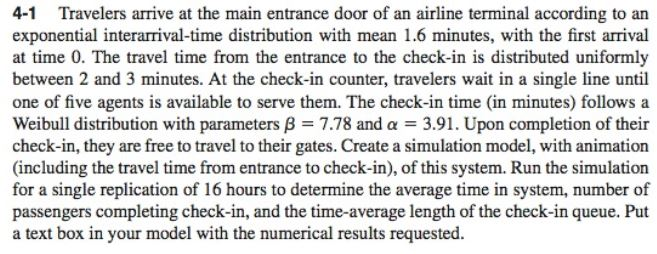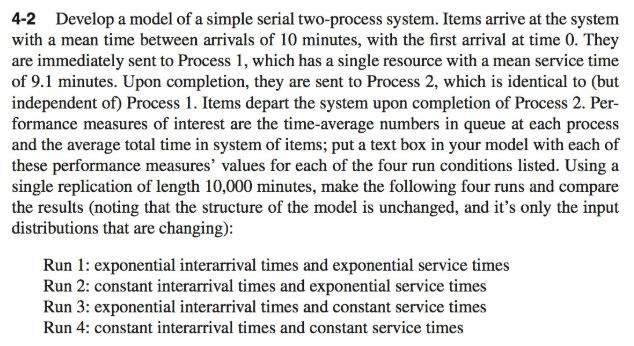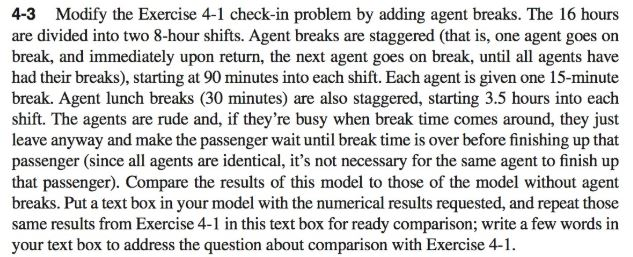


4-1 Travelers arrive at the main entrance door of an airline terminal according to an exponential interarrival-time distribution with mean 1.6 minutes, with the first arrival at time 0. The travel time from the entrance to the check-in is distributed uniformly between 2 and 3 minutes. At the check-in counter, travelers wait in a single line until one of five agents is available to serve them. The check-in time in minutes) follows a Weibull distribution with parameters B = 7.78 and a = 3.91. Upon completion of their check-in, they are free to travel to their gates. Create a simulation model, with animation (including the travel time from entrance to check-in), of this system. Run the simulation for a single replication of 16 hours to determine the average time in system, number of passengers completing check-in, and the time-average length of the check-in queue. Put a text box in your model with the numerical results requested. 4-2 Develop a model of a simple serial two-process system. Items arrive at the system with a mean time between arrivals of 10 minutes, with the first arrival at time 0. They are immediately sent to Process 1, which has a single resource with a mean service time of 9.1 minutes. Upon completion, they are sent to Process 2, which is identical to (but independent of) Process 1. Items depart the system upon completion of Process 2. Per- formance measures of interest are the time-average numbers in queue at each process and the average total time in system of items; put a text box in your model with each of these performance measures' values for each of the four run conditions listed. Using a single replication of length 10,000 minutes, make the following four runs and compare the results (noting that the structure of the model is unchanged, and it's only the input distributions that are changing): Run 1: exponential interarrival times and exponential service times Run 2: constant interarrival times and exponential service times Run 3: exponential interarrival times and constant service times Run 4: constant interarrival times and constant service times 4-3 Modify the Exercise 4-1 check-in problem by adding agent breaks. The 16 hours are divided into two 8-hour shifts. Agent breaks are staggered (that is, one agent goes on break, and immediately upon return, the next agent goes on break, until all agents have had their breaks), starting at 90 minutes into each shift. Each agent is given one 15-minute break. Agent lunch breaks (30 minutes) are also staggered, starting 3.5 hours into each shift. The agents are rude and, if they're busy when break time comes around, they just leave anyway and make the passenger wait until break time is over before finishing up that passenger (since all agents are identical, it's not necessary for the same agent to finish up that passenger). Compare the results of this model to those of the model without agent breaks. Put a text box in your model with the numerical results requested, and repeat those same results from Exercise 4-1 in this text box for ready comparison; write a few words in your text box to address the question about comparison with Exercise 4-1. 4-1 Travelers arrive at the main entrance door of an airline terminal according to an exponential interarrival-time distribution with mean 1.6 minutes, with the first arrival at time 0. The travel time from the entrance to the check-in is distributed uniformly between 2 and 3 minutes. At the check-in counter, travelers wait in a single line until one of five agents is available to serve them. The check-in time in minutes) follows a Weibull distribution with parameters B = 7.78 and a = 3.91. Upon completion of their check-in, they are free to travel to their gates. Create a simulation model, with animation (including the travel time from entrance to check-in), of this system. Run the simulation for a single replication of 16 hours to determine the average time in system, number of passengers completing check-in, and the time-average length of the check-in queue. Put a text box in your model with the numerical results requested. 4-2 Develop a model of a simple serial two-process system. Items arrive at the system with a mean time between arrivals of 10 minutes, with the first arrival at time 0. They are immediately sent to Process 1, which has a single resource with a mean service time of 9.1 minutes. Upon completion, they are sent to Process 2, which is identical to (but independent of) Process 1. Items depart the system upon completion of Process 2. Per- formance measures of interest are the time-average numbers in queue at each process and the average total time in system of items; put a text box in your model with each of these performance measures' values for each of the four run conditions listed. Using a single replication of length 10,000 minutes, make the following four runs and compare the results (noting that the structure of the model is unchanged, and it's only the input distributions that are changing): Run 1: exponential interarrival times and exponential service times Run 2: constant interarrival times and exponential service times Run 3: exponential interarrival times and constant service times Run 4: constant interarrival times and constant service times 4-3 Modify the Exercise 4-1 check-in problem by adding agent breaks. The 16 hours are divided into two 8-hour shifts. Agent breaks are staggered (that is, one agent goes on break, and immediately upon return, the next agent goes on break, until all agents have had their breaks), starting at 90 minutes into each shift. Each agent is given one 15-minute break. Agent lunch breaks (30 minutes) are also staggered, starting 3.5 hours into each shift. The agents are rude and, if they're busy when break time comes around, they just leave anyway and make the passenger wait until break time is over before finishing up that passenger (since all agents are identical, it's not necessary for the same agent to finish up that passenger). Compare the results of this model to those of the model without agent breaks. Put a text box in your model with the numerical results requested, and repeat those same results from Exercise 4-1 in this text box for ready comparison; write a few words in your text box to address the question about comparison with Exercise 4-1









